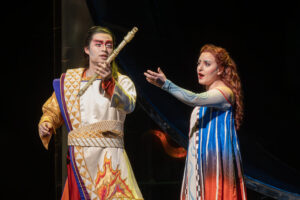

After some time warming up earlier, these songs showed his head register well blended with the rest of his voice, and allowed Appleby to float upwards easily to tender and touching effect.
He pronounced American English with great naturalness and innate charm, and finally, after a lot of moving around and gesturing earlier, he just stood and sang, letting his voice and manner carry the songs.
Though for now the young singer is a high lyric he caught the rough, persnickety style of Ives perfectly and was able to achieve the necessary grandeur of a great song like The Housatonic at Stockbridge, as well as the tough sweetness of Berceuse (1900-03).
The beautiful Rorem songs were spun out with the right hint of nostalgia and longing, and A Terrible Disaster (1947) was gorgeous.
The program was ambitious and included two very demanding cycles from the mid-1930s: On this Island by Benjamin Britten, texts by W.H. Auden. And, very challenging indeed, Francis Poulenc’s Tel jour telle nuit, poems by the great poet he called his “brother”, Paul Éluard.
Appleby spoke to the audience about both, before the Britten group, essentially providing program notes, understandable perhaps, as the printed program had none. But this is a risky thing to do in recital. Audiences can’t always absorb the information that quickly and for those who don’t know the pieces it may be better to let the songs work directly.
I noticed that in his first group, six songs by Schubert, Appleby had been inclined to attitudinize and gesture. And this continued. Nerves may have been part of it, for despite his lovely singing (at a rather slow tempo) of Schubert’s sublime Lied eines Schiffers an die Dioskuren, his voice seemed slow to settle. He may have been adjusting to the very resonant acoustic of Benjamin Franklin Hall.
Now. Mr. Appleby is not alone among his generation of vocal recitalists. Times and audiences change. I know that Dawn Upshaw and Thomas Hampson have encouraged students to think of recitals as “conversations.” But for what it’s worth I found it a distraction.
In any case, Britten’s work, an early piece, is difficult for a singer to solve. It is much tamer harmonically than Britten’s other pieces of the period and much of the musical interest is in the piano part. Britten uses his understanding of the instrument to provide a lot of surprises, avoiding a degree of musical predictability. Noda played this with notable skill.
The melodic line, quite sequential, is not as memorable as would be the case in many future collections. The singer must locate himself in an ambiguous place. The songs are recognizably genre pieces, quietly sending up some of the styles of the period, although the poems contain a degree of disquiet, sadness and protest. Only the final (and weakest) song, As it is, plenty, lands obviously as a parody (and the audience enjoyed it most). Appleby did not find a convincing approach and some of the songs took him into a rather weak sounding lower register.
Tel jour telle nuit is a weightier more complex work. It is really a cycle, the nine songs are related by key, motifs and other harmonic references. It ends with an eloquent postlude for piano—a conscious reference to Schumann’s Dichterliebe. The cycle is a day in the life of two lovers who wake up, live through joy, worry, sorrow, and go to sleep.
Éluard was a Surrealist and his complex poems are full of strange, distorted images and references (it was dedicated to Pablo Picasso). Poulenc’s amazing setting (many consider this his greatest cycle) has an uncanny way of mirroring the twists and turns of the poet, and adding a dense, sometimes jazzy, sometimes expansive emotional musical narrative.
Appleby was serious and very intelligent. But this is a difficult challenge for someone not born to the language, and perhaps, not completely sure-footed in the musical style. He did some strong singing, particular in Figure du force brúlante et farouche but the whole seemed unfinished.
Still, if one was aware of a young singer still working to find the center of his interpretive persona, there were many rewards here. Appleby’s lovely singing, especially toward the end of the evening, his sensitivity to text and secure musicality are more than merely promising. One can hope for great things from him.
Photo: Dario Acosta

























Comments